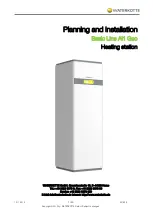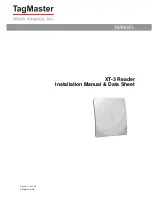
29
RISERVATO AL PERSONALE AUTORIZZATO ALL'INSTALLAZIONE - ONLY FOR INSTALLATION-AUTHORIZED STAFF
IST DEM ZUR INSTALLATION AUTORISIERTEN PERSONAL VORBEHALTEN - SEULEMENT POUR LE PERSONNEL AUTORISE A L'INSTALLATION - RESERVADO
AL PERSONAL ENCARGADO DE LA INSTALACION
0580-M020-0-P1
SF 5505 IF - SF 5506 I - SF 5507 IF - SF 5508 I
SF 5508 MI - SF 5509 IF - SF 5510 - SF 5510 I
4.9 Spurgo aria
Il sollevatore viene fornito con l'impianto idraulico montato e
spurgato dall'aria; durante il collegamento dei tubi potrebbe
entrare un po' di aria e quindi, per ristabilire il corretto funzio-
namento, operare come segue: con il rubinetto
R
chiuso, vedi
Fig.
10
, premere il pulsante di salita fino a battuta meccanica
pedana
P1
(non importa la pedana
P2
).
Svitare la vite (
1
) (Fig.
11
) del cilindro
P1
per spurgare l'aria (può
verificarsi la discesa di
P2
) poi riavvitare.
Togliere l'alimentazione pneumatica in modo che l'arresto
meccanico del cilindro
P1
rimanga agganciato sull'ultimo dente
(cilindro tutto esteso) e inserire sotto l'arresto del cilindro
P2
il
distanziale (
2
Fig.
11
) in modo che il cilindro possa scorrere.
Aprire il rubinetto
R
(Fig.
10
) e premendo il pulsante di discesa
fare scendere
P2
fino a terra, poi farla risalire 3-4 volte fino a 50-
70 cm da terra. Assicurarsi che in centralina ci sia olio sufficiente.
Portare
P2
a 150 cm di altezza e chiudere il rubinetto
R
, fare
scendere il ponte di c. a. 50 cm dopo aver tolto il distanziale
2
(Fig.
11
) e ripristinato il collegamento pneumatico, poi riaprire il rubi-
netto
R
. Mettere la
P2
0,5-1 cm.più bassa di
P1
. Richiudere il
rubinetto
R
bloccando con gli appositi controdadi e fare scen-
dere a terra entrambe le pedane.
Staccare lo spinotto A (Fig.7).
Il ponte funziona regolarmente quando partendo da terra ad
un'altezza di 10 cm
P2
risulta più alta di
P1
di 1-2 cm.
N.B. In condizioni di esercizio lo spinotto A deve
essere disinserito.
4.9 Bleeding the air
The lift is supplied with the hydraulic system installed and with
the air bled. However while the tubing is being connected, air
may enter and you should proceed as follows to restore the
machine to correct working conditions: with the tap
R
closed,
press the rise button until
P1
reaches mechanical block (the
position of
P2
is not important). Unscrew screw (
1
) (Fig.
11
) of the
P1
cylinders to bleed the air (P2 may descend) then tighten
again. Switch off the compressed air supply so that the
mechanical stop of the
P1
cylinder is hooked onto the last tooth
(cylinder fully extended) and fit the spacer (
2
) (Fig.
11
) beneath
the
P2
cylinder stop so that the cylinder can slide.
Open tap
R
(Fig.
10
) and press the descent button to lower
P2
to the ground, then raise it again 3-4 times 50-70 cm from the
ground. Check that there is enough oil in the central unit. Raise
P2 to 150 cm and close tap
R
, lower the lift about 50 cm, after
removing the spacer (
2
) (Fig.
11
) and turning on the compressed
air supply again, then open tap R again.
Place
P2
so that it is 0.5-1 cm lower than
P1
. Close tap
R
again,
fastening with the counternuts and lower both footboards to the
ground.
Remove plug A (Fig. 7).
The lift is working properly
when
P2
is 1-2 cm higher than
P1
after reaching a height of 10
cm from the ground.
NB. During operation, plug A must be disabled.
4.9 Entlüftung
Die Hebebühne wird folgendermassen geliefert: mit montierter
Hydraulikanlage und entlüftet. Während des Anschlusses der
Leitungen könnte etwas Luft eintreten. Zur Abhilfe bzw.
Wiederherstellung des einwandfreien Betriebes wie folgt vorgehen:
Mit dem Hahn
R
geschlossen, siehe Abb.
10
die Taste „Heben“
bis zum mechanischen Anschlag der Fahrschiene
P1
betätigen
(die Fahrschiene
P2
ist unwichtig). Zur Entlüftung die Schraube
(
1
Abb.
11
) des Zylinders
P1
lösen (
P2
könnte sich senken) und
wieder anziehen. Die pneumatische Versorgung unterbrechen,
damit die mechanische Arretierung des Zylinders
P1
auf dem
letzten Zahn eingehakt bleibt (Zylinder ganz ausgefahren) und
zur Zylindergleitung das Distanzstück (
2
Abb.
11
) unter die
Arretierung des Zylinders
P2
einsetzen.
Den Hahn
R
(Abb.
10
) öffnen und unter Betätigung der Taste
„Senken“
P2
bodeneben absenken lassen und 3-4 Mal wieder
bis auf 50-70 cm hochfahren. Sicherstellen, dass im
Schaltschrank genügend Öl vorhanden ist. P2 auf 150 cm
hochfahren und den Hahn „
R
“ schliessen. Die Hebebühne um ca.
50 cm runterfahren lassen, nachdem das Distanzstück
2
(Abb.
11
)
entfernt und der pneumatische Anschluss wieder hergestellt
worden sind. Nun den Hahn „
R
“ wieder öffnen.
P2
um 0,5 - 1 cm
tiefer als
P1
setzen. Den Hahn
R
erneut schliessen, indem mit
den entsprechenden Kontermuttern blockiert wird und beide
Fahrschienen bodeneben absenken lassen.
Den Stecker A
(Abb. 7) ausziehen.
Die Hebebühne funktioniert dann
einwandfrei, wenn beim Anheben vom Boden auf einer Höhe
von 10 cm die
P2
um 1-2 cm höher als die
P1
liegt.
4.9 Purge de l’air
Le pont élévateur est fourni au client avec l’installation
pneumatique montée et purgée de l’air: au moment de la
connexion des câbles, de l’air pourrait s’introduire dans le
système, il faut donc opérer comme suit pour rétablir le bon
fonctionnement: le robinet
R
doit être fermé (voir Fig.
10
): actionner
la montée autant qu’il faut pour porter le chemin de roulement
P1
dans sa position de butée mécanique (peu importe la position
du chemin de roulement
P2
).
Desserrer la vis (
1
Fig.
11
) du cylindre
P1
pour purger l’air (il peut
arriver que
P2
descende), puis resserrer.
Supprimer l’alimentation pneumatique de manière à ce que l’arrêt
mécanique du cylindre
P1
reste enclenché sur la dernière dent
(cylindre entièrement ouvert) et introduire sous l’arrêt du cylindre
P2
l’entretoise (
2
Fig.
11
) pour permettre au cylindre de coulisser.
Ouvrir le robinet
R
(Fig.
10
) et appuyer sur le bouton de descente
pour porter
P2
à terre, le soulever ensuite
3
ou
4
fois de 50 à 70
cm de terre. S’assurer qu’il y ait suffisamment d’huile dans la
centrale. Porter P2 à une hauteur de 150 cm et fermer le robinet
R
. Faire descendre le pont de 50 cm environ après avoir retiré
l’entretoise
2
(Fig.
11
) et réactivé l’installation pneumatique, puis
rouvrir le robinet
R
.
Positionner
P2
à une hauteur inférieure de 0,5 - 1 cm de
P1
.
Refermer le robinet
R
en bloquant les contre-écrous spécifiques
et porter les deux chemins de roulement à terre.
Débrancher la
fiche A (Fig. 7).
Le pont fonctionne régulièrement lorsqu’il
démarre d’une hauteur de 10 cm de terre et que
P2
dépasse
P1
de 1 ou 2 cm.
4.9 Purga del aire
El elevador se entrega con la instalación hidráulica montada y
purgada de aire; durante la conexión de los tubos podría entrar
un poco de aire y por este motivo, para restablecer el correcto
funcionamiento hay que maniobrar de la siguiente manera: con
el grifo
R
cerrado, ver Fig.
10
, apretar el pulsador de elevación
hasta el tope mecánico de la tarima
P1
no importa la posición
de la tarima
P2
). Desatornillar el tornillo
1
(Fig.
11
) del cilindro
P1
para purgar el aire (puede comprobarse el descendo de
P2
) y
luego volver a atornillar. Quitar la alimentación neumática de
manera que el retén mecánico del cilindro
P1
se quede
enganchado en el último
diente (cilindro todo abierto) y
colocar debajo del retén del cilindro
P2
el distanciador
2
(Fig.
11
)
de manera que el cilindro
pueda deslizar. Abrir el grifo
R
(Fig.
10
) y apretando el pulsador de descenso bajar
P2
hasta el
suelo, y luego subirla 3-4 veces hasta que llegue a unos 50-70
cm. del suelo. Asegurarse de que en la caja de control haya
bastante aceite. Poner
P2
a 150 cm. de altura y cerrar el grifo
R
; bajar el puente unos 50 cm. después de haber quitado el
distanciador
2
(Fig.
11
) y de haber restablecido la conexión
neumática, y luego volver a abrir el grifo
R
. Poner la
P2
de 0,5
a 1 cm. más abajo de
P1
. Volver a cerrar el grifo bloqueando con
las correspondientes tuercas de inmovilización y bajar al suelo
las dos tarima. Desconectar el enchufe
A
(Fig.
7
). El puente
funciona normal cuando empezando desde el suelo, a una
altura de 10 cm,
P2
es más alta de
P1
uno o dos centímetros.
NOTA: en condiciones de utilización, el enchufe A
tiene que estar desconectado.
















































